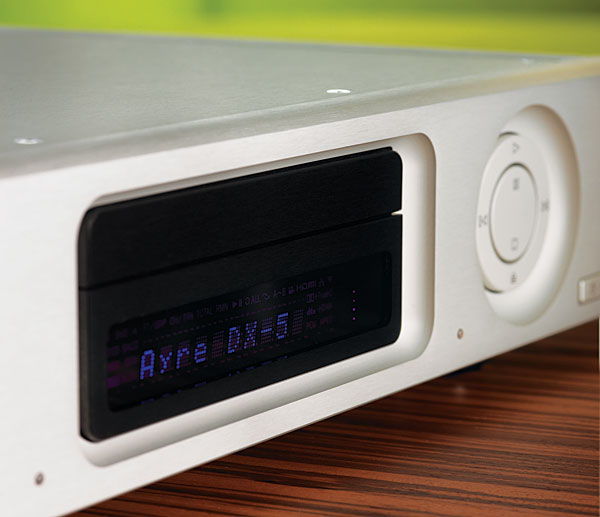| Columns Retired Columns & Blogs |
Hi! Was DX-5 connected to the system via the balanced output? If that's the case, what's the XLR input polarity of DartZeel? I could not find this information on DartZeel's website. Thanks.
Don't forget to properly configure the computer's digital output before you listen to any music. And if you use a Mac, be sure to download and buy either Pure Music ($129) or the more expensive Amarra program, both of which bypass Apple's mediocre audio engine and use iTunes merely as a "skin" for accessing and retrieving your music files. The audible improvement is not subtle. Ayre is preparing its own iTunes bypass software, called AyreWave, but the beta version gave us trouble during the initial setup. I went with Pure Music, which also has configuration pages packed with jargon that will leave many dizzy (see my review of Pure Vinyl in the August issue); but, once it's up and working, it's usually stable.

If you love iTunes, you're all set, other than the fact that iTunes can't play the popular FLAC format. (A program called Max will convert FLAC files to iTunes-compatible formats, but it's just another annoying step.)
The DX-5 as SACD player
The Ayre DX-5 was a pleasant-sounding SACD player, but its performance wasn't spellbinding. I auditioned David Chesky's superb Area 31 (SACD, Chesky SACD288). I strongly recommend this SACD; the three works on it are edgy and riveting contemporary classical music, and the sound is spectacular. In the Violin Concerto, with soloist Tom Chiu, conductor Anthony Aibel, and Area 31, the handclaps should be sharp, the strings searing, the timpani bold, the stage deep and spacious. The DX-5's rendering was more about warmly holding the picture together than about letting individual orchestral instruments break free and assert themselves. The Ayre's soundstage was also smaller than I expected from this SACD in both width and depth.
When I played Mobile Fidelity Sound Lab's outstanding SACD of the Band's Music from Big Pink (Capitol/Mobile Fidelity Sound Lab UDSACD 2044) on the DX-5, I was surprised by how reserved and smooth it sounded compared to what I'm used to. Again, the DX-5 produced a lush, rich, warm, but somewhat soft overall sound, particularly at the bottom end. Playing the excellent-sounding SACD of Roxy Music's Avalon, bass lines were softer and warmer through the DX-5, shakers and gourds less sharply drawn, and the overall picture was softer. Bryan Ferry's voice seemed diffuse and recessed through the DX-5, perhaps because the reverberant backdrop blended with his voice instead of separating out in space.
I compared the Ayre playing SACDs to the considerably more expensive Playback Designs MPS-5 SACD player (see my review in the February 2010 issue)—the DX-5's output was considerably lower than that of the MPS-5; I had to take great care to match output levels before drawing any conclusions. The Playback was more "event oriented," dynamic, and three-dimensional, with blacker backgrounds; the DX-5 was more about delicacy, richness, and atmospherics, less about punch and plumbing the depths. Roughly speaking, it was sort of like the difference between a Lyra Titan i and a Benz Micro LP S—superb but very different-sounding cartridges.
The DX-5 as DVD-Audio player
Here's where things began to get exciting. For whatever reasons, the Ayre DX-5 played DVD-As closer to how the Playback MPS-5 reproduced SACDs. I don't care if the same filters are at work, the sound was very different: far more expansive, exuberant, and engaging, yet still smoooooth in the best sense of that word. Overall, the DX-5's sound was smooth and almost golden-toned, regardless of format or resolution.
As Wes Phillips wrote in his QB-9 review, here's digital sound with analog flow. If you want a good laugh, compare the DVD-A of producer George Martin's remixes of Beatles songs on Love (Apple/Capitol 3 79810 2 5) with the CD edition. The DVD-A has space, life, transparency, flow; the CD sounds drab and compressed. It's almost like the difference between a CD and an MP3. You can sink your ears into the rich-sounding DVD-A in ways you can't with any CD in my experience.
It was liberating to pull out my box of dusty DVD-As and play them at last. Some were great, some not. For instance, I'm certain tacky reverb was added to the Grateful Dead's Workingman's Dead (Warner Bros.), rendering it silly. On the other hand, the DVD-A of The Band's Music from Big Pink was stunning, with Levon Helm's drum kit having a full, deep fury that I'm told was chopped by Capitol from the original LP, and somewhat tamed and softened on Mobile Fidelity Sound Lab's outstanding SACD (Capitol/Mobile Fidelity Sound Lab UDSACD 2044) through the DX-5.
So much work and money went into the failed format of DVD-Audio. I have a disc of Gerry Rafferty's somewhat obscure Can I Have My Money Back?, originally issued on Transatlantic in the UK (Blue Thumb/Silverline)—this was before "Baker Street." It's one of my favorite pop albums, and Silverline went to the trouble of remixing it for surround sound. The DVD-A package contains a second copy of the album, on CD, as well as really well-done notes and extras. The stereo mixdown on the DVD-A sounded precise, detailed, and three-dimensional via the DX-5, bettering the LP in a few ways, though of course [you can finish the sentence] (footnote 2).

Hi! Was DX-5 connected to the system via the balanced output? If that's the case, what's the XLR input polarity of DartZeel? I could not find this information on DartZeel's website. Thanks.
